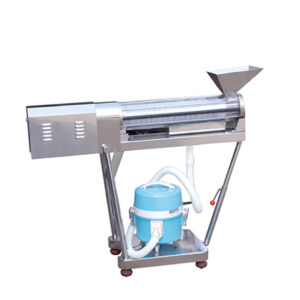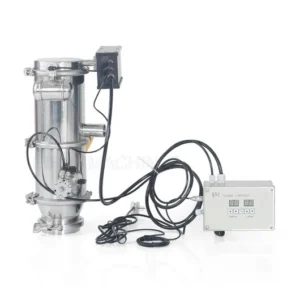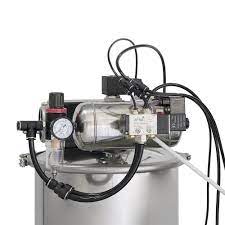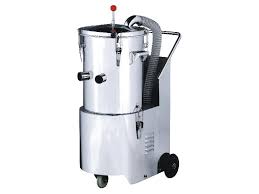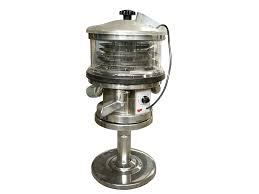Pharmaceutical Assistant Machine
Introducing the Qualipak Pharmaceutical Assistant Machine: transform your pharmaceutical manufacturing process! Get rid of the dull procedures with automation that is precise and a technology that is on the edge. This is done to make sure things are right, efficient and in line with all regulatory demands. Elevate your production capabilities with Qualipak’s trusted solution. Upgrade today and experience the future of pharmaceutical manufacturing.
Introduction of Pharmaceutical Assistant Machine
Technological advancements in healthcare are constantly redefining the way medical services are delivered in today’s ever-evolving landscape. One such innovation that has gained significant traction is the Pharmaceutical Assistant Machine (PAM). PAMs automate a lot of pharmacy activities that were traditionally carried out by pharmacists or pharmacy technicians and this is revolutionizing pharmacy operations. This article looks at the types, working processes, applications, functions, benefits, future trends, maintenance and training of Pharmaceutical Assistant Machines.
Types of Pharmaceutical Assistant Machines
Different kinds of Pharmaceutical Assistant Machines exist for specific streamlining of various facets of the pharmacy. Some commonly identified types include:
1. Dispensing Robots
Dispensing robots handle pill counting accurately and correctly to avoid dispensing errors through automation. The equipment uses sophisticated vision systems and robotics technology to cover a wider range of pill sizes and shapes.
2. Automated Dispensing Cabinets (ADCs)
Automated dispensing cabinets are designed for use within hospitals or other healthcare establishments where they offer secure storage for medicines being dispensed thereby allowing healthcare providers to access prescribed medications quickly.
3. Prescription Vending Machines
Patients can conveniently pick up their prescriptions at self-service kiosks called prescription vending machines. These machines can be located within pharmacies, hospitals or other health facilities enabling them to obtain drugs all day long throughout the week.
4. Pharmacy Management Systems
Pharmacy management systems integrate various pharmacy processes including inventory management, prescription processing as well as billing among others which often feature elements such as electronic prescribing or medication therapy management.
Working Processes of Pharmaceutical Assistant Machines
However, most machines work based on similar principles:
1. Data Input
Prescription information or medication orders from pharmacists will have been entered by a hospital staff into a machine software system manually or electronically integrated with their EHR system.
2. Medication Verification
The accuracy of the prescription is checked by the machine against the patient’s medical history and any other medications that have been taken in conjunction with allergies.
3. Dispensing or Storage
The medicine is either dispensed to the patient directly or the medication is securely stored until healthcare providers need it depending on whether it is a dispensing machine or storage system.
4. Labeling and Packaging
After dispensing medicines, the machine will print labels containing dosage instructions, and relevant details about the patient. In some cases, machines can put individual doses into packages for convenience.
5. Patient Interaction (for Prescription Vending Machines)
Patients operate such machines to get their prescriptions in case vending machines are used for prescription purposes alone anytime during the day or night by entering distinct codes or scanning barcodes.
Applications of Pharmaceutical Assistant Machines
Pharmaceutical Assistant Machines are utilized in several ways across healthcare settings including:
1. Retail Pharmacies
PAMs that automate prescription filling procedures within retail pharmacies shorten waiting times for patients as well as leave more time for pharmacy staff to concentrate on counselling them while performing other important tasks.
2. Hospital Pharmacies
PAMs increase efficiency in medication dispensing and administration within hospital setups thus ensuring proper timing of drugs given to patients. In hospitals particularly, ADCs are very helpful when it comes to managing medication inventory thereby enhancing safety among patients who receive treatment there.
3. Long-Term Care Facilities
Many long-term care facilities such as nursing homes and assisted living centers use PAMs to handle multiple residents’ complex drug regimens because they promote adherence rates and minimize errors in prescribing.
4. Tele pharmacy
Tele pharmacy settings are places where prescription reviews and verifications are done by remote pharmacists who rely on PAMs to ensure that drugs are dispensed accurately and efficiently.
Roles of Pharmaceutical Assistant Machines
Pharmaceutical assistant machines perform several functions that aim at improving the efficiency of the pharmacy as well as care for patients. These include:
1. Automated Dispensing
PAMS counts, dispenses and labels medications through an automation process to minimize human mistakes and improve precision in medication.
2. Inventory Management
Many PAMs have features for managing inventory which track stock levels of medicines, expiry dates, and reorder points among others guaranteeing there is a sufficient supply of essential drugs.
3. Medication Safety
By intersecting prescription information with patient medical records and drug databases, such systems help in averting wrong medication such as oversize or drug contraindications.
4. Patient Convenience
Prescription vending machines enable patients to access their prescriptions even after pharmacy hours thereby increasing medicine adherence rates and overall patient satisfaction.
5. Workflow Optimization
PAM technology allows pharmacies to automate routine tasks thus freeing up staff time for more valuable activities like medication counselling, medication therapy management (MTM) and patient education.
Advantages Associated with Pharmaceutical Assistant Machines
Pharmaceutical Assistant Machines present several benefits for healthcare providers as well as patients:
1. Improved Efficiency
With automated pill counting and prescription filling, PAMs take over time-consuming tasks making it possible for more patients to be served within shorter periods.
2. Enhanced Accuracy
Due to reduced chances of errors by human beings, this technology leads to greater accuracy in medicine dosage leading to better patient outcomes with less liability on the part of healthcare workers,
3. Cost Savings
Despite the high cost associated with installing PAMs initially, increased efficiency; reduced labour costs; and minimized cases of medication errors can save a substantial amount over a long duration period compared to traditional manual dispensing methods usually in use.
4. Expanded Access to Care
Pharmacy services are not limited to normal working hours owing to the availability of prescription vending machines, which provide medicines on demand whenever patients need them.
5. Regulatory Compliance
To avoid being fined or sanctioned for noncompliance with medication labeling and documentation standards, some pharmacies have chosen to equip themselves with PAMs thereby making it easy for them to meet these requirements with ease.
Emerging Trends in Pharmaceutical Assistant Machines
The future of pharmaceutical assistant machines is influenced by several developments occasioned by advancements in technology:
1. Integration with Artificial Intelligence (AI)
Through the utilization of AI-based algorithms, patient data can be analyzed and used to predict drug intake behaviours as well as potential adverse effects resulting from interactions between drugs.
2. Personalized Medicine
Genomic medicine and pharmacogenomics advances have led to the development of personalized assistant machines that can adjust the medication dosage according to an individual’s genetic makeup hence enhancing treatment efficiency while minimizing undesired side effects.
3. Remote Monitoring
PAMs equipped with remote monitoring capabilities allow pharmacists to track patient medication adherence so that they can take timely action when there is any issue such as missing a dose or failing to comply with the recommended medication regimen,
4. Telepharmacy Expansion
As telemedicine and telepharmacy keep growing, there will be a need for effective PAMs that can support remote prescription verification and supplies thus enabling pharmacists to reach underserved patients residing in rural areas.
5. Enhanced Security Features
In future, PAMs may be designed in a way meant to prevent the theft of medicines and guarantee the safety of users through the incorporation of more advanced security options such as biometric authentication and tamper-resistant packaging among others,
Maintenance and training for pharmaceutical assistant machines
1. Regular Maintenance
To keep PAMs operating smoothly and avoid potential breakdowns, regular maintenance is important. Key maintenance tasks entail:
Cleaning: Cleaning regularly the components of the machine such as dispensing mechanisms and conveyor belts avoids the accumulation of dust, debris or any residue that could interfere with the machine’s operation.
Calibration: The periodic calibration of sensors and measuring devices in the machine ensures that accurate medication dispensing and labelling are done. Calibration schedules may vary depending on the type of PAM used and the volume of medications dispensed.
Software Updates: It is very essential to keep the software of a machine up-to-date as this incorporates bug fixes, security patches, or even new features. Pharmacies should frequently check for software updates offered by manufacturers that they can install.
Inspecting Moving Parts: Regular inspection of moving parts like motors, gears, and actuators helps identify wear or tear or damage indicating the need for repair or replacement.
Inventory Management: To prevent stockouts or dispensation of expired drugs pharmacists need to monitor drug inventory levels and expiration dates. In addition, pharmacies should establish protocols for regular inventory checks & replenishment.
2. Technical Support
Having a good relationship with qualified technical support providers guarantees quick problem-solving in case PAM fails at any time in future. The main things that should be considered in terms of technical support include:
Vendor Support: To access technical support services pharmacies should work closely with the vendor/manufacturer of PAM. This may involve signing a service agreement or buying a maintenance plan that allows for onsite support & repairs. In some cases, this can only be done by calling your doctor if you have insurance coverage under their plan.
Remote Diagnostics: Some PAMS may offer remote diagnostic capabilities enabling technicians to troubleshoot issues remotely as well as perform software updates. Thus upon selection, PAM Pharmacies must enquire about the availability of remote support options provided.
Emergency Response: In case of a critical failure or malfunction, pharmacies need to have access to emergency technical support services to reduce downtime as well as disruption of pharmacy operations.
Training for In-House Technicians: Pharmacies with in-house technical staff should provide comprehensive training on PAM maintenance and troubleshooting procedures. This ensures that staff are equipped to handle routine maintenance tasks and minor repairs independently.
3. Staff Training
Proper training is essential for pharmacy staff to effectively operate and maintain PAMs. There are different areas that a training program should cover:
Machine Operation: Loading medications, inputting prescription information, and troubleshooting common issues such as power outages, machine malfunctions or medication dispense errors are some of the things that staff should be thoroughly trained on about operating PAM.
Safety Protocols: Training ought to emphasize safety protocols in handling medicines and the operation of the PAM to minimize the occurrence of accidents or injuries.
Emergency Procedures: Such emergency measures may include what must be done during a power outage, and machine malfunctions like medication dispensing mistakes amongst others. Staff members need training in these procedures so they can react quickly if an accident does happen at their workplace, but there isn’t any detailed explanation regarding this matter anywhere else within chapter two (or even later chapters) which makes me question whether or not this entire book was just created solely based off one chapter written years ago without any thought given into how subsequent ones would tie back into.[4]
Continuing Education: Therefore, there should be regular continuing education opportunities whereby staff can get updates on new features/ software upgrades/best practices for PAM operation & maintenance.
Documentation: Consequently staff needs enlightenment on how to keep accurate records of various activities like cleaning schedules, calibration logs and inventory audits among others.
Thus by giving priority to regular maintenance as well as extensive staff training facilities can maximize their Pharmaceutical Assistant Machines’ efficiency/reliability/lifespan thereby improving patient care as well as satisfaction.
FAQs
- What is a Pharmaceutical Assistant Machine (PAM)?
A pharmaceutical assistant machine is an advanced technology that automates several processes within pharmacy operations such as medication dispensing, labelling and inventory management. It can also be called an automated pharmacy system.
- How does a Pharmaceutical Assistant Machine work?
The way PAMs operate is that they first receive the prescription information, verify it for accuracy, dispense the prescribed medications, label them with dosage instructions and pack them for distribution or pick-up.
- Different kinds of Pharmaceutical Assistant Machines are there?
Common types include but are not limited to dispensing robots; automated dispensing cabinets (ADCs); prescription vending machines; and pharmacy management systems.
- What advantages can be derived from using Pharmaceutical Assistant Machines?
Some of the benefits of this system include increased efficiency; improved accuracy in medication dispensing; reduced labor costs translating into cost savings; greater availability of care via a 24/7 option for picking up prescriptions and better regulation compliance.
- Are Pharmaceutical Assistant Machines safe to use?
PAM has been designed with safety features to reduce medication errors resulting in patient injuries. Nevertheless, proper training as well as conducting operations according to operational protocols will minimize such risks.
- Can all medications be accepted by Pharmaceutical Assistant Machines?
Although PAMs can process many different drugs including pills, tablets, capsules and liquid medicines, some limitations may arise depending on the specific machine used. Some special types of medicines or certain forms of dosage may demand manual handling.
- How do pharmacies maintain their Pharmaceutical Assistant Machines?
Maintenance involves cleaning, calibration of sensors, software updates and checking moving parts among others. Pharmacy relationships with technical support providers help in case troubleshooting or repairs are needed.
- Which training should pharmacy staff get so that they can operate Pharmaceutical Assistant Machines?
There should be comprehensive training on PAM operation by pharmacy staff which also covers safety protocols, emergency procedures and maintenance tasks. Also, continuing education must always update them on new features or software upgrades as they come along.
- Can these machines integrate with existing pharmacy management systems?
Yes, most PAMs are made to work seamlessly with present-day pharmacy management systems electronic health records (EHR) systems and other healthcare information technology platforms thereby streamlining workflow thus increasing efficiency.
- What does the future hold for Pharmaceutical Assistant Machines?
These predictions include the integration of AI with PAMs to enable advanced analytics and personalized medicine. Remote monitoring is another trend in PAMs that supports proactive patient care. Moreover, they have enhanced security features to prevent medication diversion, thus ensuring patient safety.

